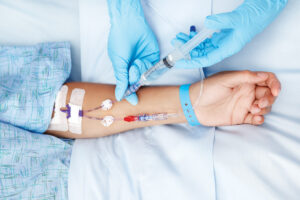All kinds of athletic activity carry the risk of suffering from a groin strain, being more usual in sporting activities which include common and forceful hip motion towards the centre of the body (hip adduction). Ice skating, hockey, swimming and soccer (football) are sports with higher incidences of groin injuries. Groin injuries may account for up to 5% of all muscular and tendinous injuries in soccer. If hip and groin pain presents in women, adolescents or children then particular and potentially more serious diagnoses should be considered.
Children with hip pain and a limp should be thoroughly investigated as the possible diagnoses include septic arthritis, a slipped epiphysis of the upper femur, Perthe’s disease and avascular necrosis of the femoral head. Such conditions require the urgent attention of an orthopaedic surgical specialist. As pain can be referred from the hip to the knee region it is important for the surrounding joints to be assessed in the examination. In adolescent athletes the growth plate at the hip is a weaker area and may be involved in traumatic injuries.
The hip is the largest joint in the body and has an extensive range of motion. It is vulnerable to damage due to its weight bearing function and repetitive activities performed. Stiffness of the hip joint may be present some time before the incidence of a groin strain and a strain may occur more readily in the presence of reduced range. Acute groin injuries such as tears, strains or sprains of the muscles and tendons occur with forceful adduction of the hip, a movement towards the midline, or if the splits occurs accidentally. Chronic groin injuries present in activities which typically overuse the muscles, such as breaststroke and running.
A groin injury can be difficult to assess as the pain areas and the type of pain described vary and can be vague. There are many medical diagnoses which can be responsible for the symptom presentation of groin pain and these need to be kept in mind. Acute injuries are common and the most prevalent is the typical groin strain, a strain of one of the many muscles running from the pelvis to the femur, maintaining the femur in the centre line under movement. Likely injuring activities include sprinting, kicking, doing the splits, running and changing direction. Sharp groin pain with some thigh radiation is typical.
The junction of where the tendon and the muscle meet is the main region of injury with bleeding from the locally ruptured muscle fibres. The formation of fibrous tissue followed by scar is the method of healing, leaving the area vulnerable to repetitive injuries, with older sports people being at higher risk than younger athletes. If the injury is severe, part of the bone can come off with the tendon, causing an avulsion injury with surgical repair being required at times. Conservative treatment is the standard management with physiotherapists employing exercise, rest and ice.
The most commonly affected muscle in groin strains is one of the inner thigh muscles, the adductor longus. The injury can be in the belly of the muscle or at the junction of the tendon and the bone. Muscle belly injuries can be treated with gentle stretches once the acute period has settled, strengthening and getting back to activity as able. Tendon and bone injuries need a slower management programme with rest until the pain settles, gentle muscle work progressing to stretching and strengthening over a period of time and a gradual return to more stressful activities.
Other possibilities for the diagnosis of pain in the groin region include abdominal hernias, often not diagnosable by physical examination, managed conservatively to start with and then if necessary with surgical care. High energy physical events may cause fractures around the hip although older people may fracture with relatively trivial force. Severe pain and limitation of hip movements and gait should be noted and referral made if needed. Sporting activities which involve repeated impacts such as running can cause stress fractures of the pubic rami or the neck of the femur. Other conditions to consider are avulsion fractures if pain onset is quick and inflammation of a bursa.


